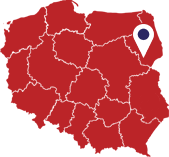The St. Wojciech’s Fair
The tradition of Fairs for the St. Wojciech’s Day in Ciechanowiec has a long history. In the XIX century Ciechanowiec was the only town in the Grodno Gubernia where a many days long open-air market was held. With reference to these traditions in the beginning of the 90’s the Rev. Krzysztof Kluk Museum of Agriculture had made attempts to reactivate the Fair. St. Wojciech is the patron of the 23rd of April, and on the Saturday closest to that day the Museum organizes the open-air market, which opens the touristic season. Folk artists, merchants, craftsmen and gardeners are invited to the Museum of Agriculture. Throughout the day the exhibitors are accompanied by performances of folk bands and musicians.
Wysokomazowiecki Inn. The gentry’s history live
Since 2005 the County of a Starost in Wysokie Mazowieckie, the Narwian National Park and the Rev. Krzysztof Kluk Museum of Agriculture had been organizing a two day long cultural event, during which the tradition and history of backwater - the impoverished polish gentry - are presented. At first the event was taking place in Kurowo, where the Narwian National Park’s seat is located, and in the Museum of Agriculture in Ciechanowiec. Since 2007 the event has moved entirely to Ciechanowiec. The event’s programme is very rich: the participants of the events are able to familiarize with the XVII cent. gentry fashion, wedding customs, court dancing, the ways of setting up a confederation and electing it’s marshal. The other attractions are: the Swedish and Moscow forces parade, as well as a swordsmanship, horse riding, artillery sergeants and jugglers demonstrations. Contests for the audience are also held during the event. Everyone can taste regional dishes, see and buy local products, as well as purchase antiques.
Ciechanowiec days fete
Ciechanowiec days fete is one of the oldest events organized in Ciechanowiec - for the first time it took place in 1976. Traditionally it is organized in the Town Stadium by the Nurzec reservoir on Saturday closest to the Midsummer Eve’s night. On that day "Championships of Sołectw" (the lowest unit of local administration, usually comprising a single villages) are riveting the attention of spectators. The Fete’s main act is the Contest for the prettiest flower wreath, lasting from the beginning of the event till the evening. After settling the contest and awarding prizes. The girls holding flower wreath and torch they are sitting down in kayaks and they are swimming for the middle of the reservoir. Then they put wreaths on the water. Throughout the fete the spectators can visit deli stands and listen to and watch the performances of music bands. The event ends with dancing and fireworks display.
Podlaskie Horse and cart driving competition
In 2005 Horse Riding Sports Club "Gepard" along with the Municipal Cultural Centre for the first time had organised the Podlaskie Horse and Cart Riding Competition. The prize was the Ciechanowiec Mayor’s Cup. This event starts with a Holy Mass, after which the procession of horses and carts is headed towards the Club’s grounds - where the competition is taking place. There are two competition categories: pairs and singles. After the competition the Lithuanian Lancers of Grabow 10th Regiment Sports-Horse Riding Association presents the art of sabre and lance wielding. During the whole event spectators may watch the gentry dress replicas presented by the Marksmen’s Society, listen to cheers and canon salvos. The programme includes performances of folk and light bands, dances and a fireworks display.
Podlaskie Bread Festival
For the first time Podlaskie Bread Festival had taken place in 2001. This festival consists of several events taking place in Ciechanowiec and the Museum’s premises: The Polish Bakers’ Cork Fishing Championships, procession from the church to the Museum, consecrating the farm animals, the harvest festival ceremony (old customs are being presented - reaping crops with a sickle and a scythe, ploughing the quail - that is dragging a young harvester through a stubble round four handfuls of not harvested crop left there). After midday the results of the contests lasting since morning are being decided: the Contest for the best baking stand and the Contest for making a „równianka”, that is a kind of a bouquet, which is consecrated in the church for Mother of God Herbaceous. Throughout the day in the Museum’s premises baking, craft and merchant stands are open for customers. It is also possible to listen to performances of folk and various other bands.
Contest of playing on folk pastoral instruments "Ligawki"
Ligawka is a traditional folk instrument, sometimes described as a natural wooden trumpet. The first Ligawki Playing Contest had taken place in Ciechanowiec in 1974. In 1980 it was transformed into the All-Poland Instruments Playing Contest. Every year over 100 contestants from all over Poland participates in the Competition. The age span of the contest’s participants varies from 3 to 86 yrs. Since a couple of years Lithuanians, Germans, Irishmen, Ukrainians, Spaniards and Australians had also been taking part in the contest. In 2006, to commemorate the originator of the competition, the long standing director and the cofounder of the Museum of Agriculture, it was named after Kazimierz Uszyński. The Competition takes place always on the first Saturday and Sunday of the Advent, in several age categories - children and adults, and musical categories - ligawka playing competition, trombit playing competition, other herding instruments playing competition.



